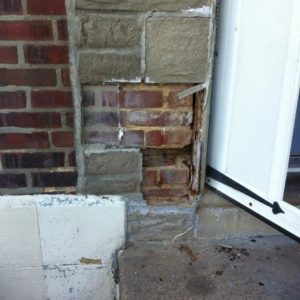Hello all! I have a customer who wants some cement tiles she has installed around her entry way. Take a look at the pic. What would be the best technique to remove the mortar from the face of the brick that does not involve acid? Can I use a grinder? If so what type of disk etc. Thank you in advance for your response!
Discussion Forum
Discussion Forum
Up Next
Video Shorts
Featured Story

Join some of the most experienced and recognized building professionals for two days of presentations, panel discussions, networking, and more.
Featured Video
SawStop's Portable Tablesaw is Bigger and Better Than BeforeHighlights
"I have learned so much thanks to the searchable articles on the FHB website. I can confidently say that I expect to be a life-long subscriber." - M.K.
Fine Homebuilding Magazine
- Home Group
- Antique Trader
- Arts & Crafts Homes
- Bank Note Reporter
- Cabin Life
- Cuisine at Home
- Fine Gardening
- Fine Woodworking
- Green Building Advisor
- Garden Gate
- Horticulture
- Keep Craft Alive
- Log Home Living
- Military Trader/Vehicles
- Numismatic News
- Numismaster
- Old Cars Weekly
- Old House Journal
- Period Homes
- Popular Woodworking
- Script
- ShopNotes
- Sports Collectors Digest
- Threads
- Timber Home Living
- Traditional Building
- Woodsmith
- World Coin News
- Writer's Digest



















Replies
would make a mess but i suppose you could use a wire cup or knotted end brush on a drill or grinder.
wire brush probably not a good idea
In my experience a metal bush tends to turn the surface of brick black...almost a "burnt" effect. Best to use a masons rub brick or a light touch of a smooth diamond cup wheel if rub brick won't cut it.
Remember that any surface of the brick that is removed reduces the weatherability of the brick itself....and the underlying compostion may be a different tone. My layman's chemistry understanding of this phenomena is that this is do to heat and atmosheric chemical reactions during the manufacturer of the product. Anyhow, removing some of the surface material in this case is pretty much unavoidable. It is, IMO, a fair trade off over the leaving the aethestics of veneer mortar residue. You'd be wise, however, to make the customer aware of this weathering issue (in writing) before beginning.
Why do you not want to use acid?
Yeah, wye not acid (HCl, muratic)
I let my 10 YO grnason play with HCl with goggles.
If HO really scared of acid, buy a few gallons of cheap vinegar (well, it is acidic also, but only 4% and considered food)
It seems to me that you want to mechanically remove as much as possible (chisels, a ligh touch with a grinder, etc), then use acid to remove the haze/crud that will remain. Be sure to wet the area first, so the acid is not absorbed too deeply into the mortar, but just works on the surface.
Well...
From the look of things in that pic anything you do once the stone's removed and you've mechanically removed as much of the remaining mortar as you can, what's left will be a pretty obvious disparity in appearance between the old, weathered brick (been exposed for years) and what was hidden behind the stone facing pieces.
Dilute muriatic (1:4 or so & add [i]acid[/i] to water to avoid boiling the water you'd be adding to the acid doing it the wrong way!) is neutralized by the alkaline nature of the mortar residue so shouldn't need but a quick hose rinse. A mild acid rinse may go along way towards evening out the appearance.
Or, if there's a small area somewhere that's similar in nature but relatively hidden from view and weather you could try sandblasting with a fairly soft particulate medium. You're gonna remove a surface layer understand but that's kind of the only way to equalize the old vs. new surfaces so go slow & have the owners' permission - in writing - to go to this extreme. Chemical or physical: the results are what you're looking to provide for your client.